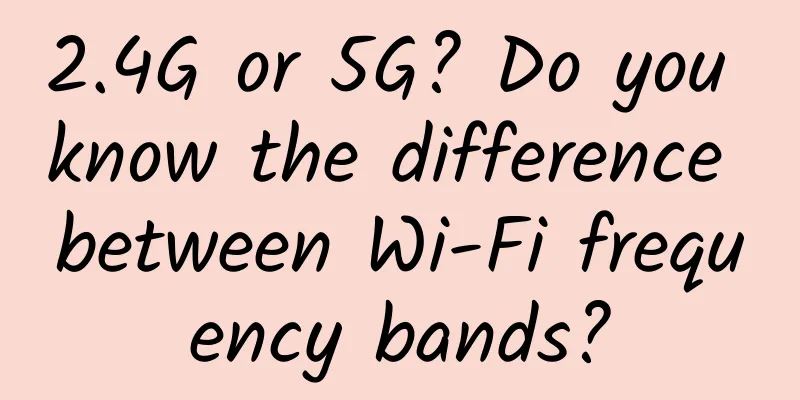2.4G or 5G? Do you know the difference between Wi-Fi frequency bands?

OverviewThe 2.4G and 5G mentioned in the title refer to the operating frequency bands of wireless devices. The 2.4G operating frequency band ranges from 2400 to 2483.5MHz. Each channel occupies about 20M. 2.4G is divided into 13 channels. The 2.4G operating frequency band is mainly based on IEEE 802.11b and other technical standards. The supported modes include 802.11b, 802.11g, 802.11b/g, 802.11b/g/n/ax. The bandwidth supports 20MH and 40MHz. The operating frequency band is 2.4GHz. The 5G operating frequency range is 5150MHz~5825MHz. The larger frequency range enables it to have 13 non-overlapping channels (channels 100~140 are not available in China). The 5G operating frequency is mainly based on the IEEE 802.11ac technical standard, supporting modes including 802.11a, 802.11a/n/ac, 802.11a/n/ac/ax, and bandwidths of 20MH, 40MHz, 80MHz and 160MHz, with an operating frequency of 5GHz. Advantages and disadvantages of 2.4G and 5GCurrently, there are many dual-band wireless devices on the market that support dual bands (2.4GHz band + 5GHz band). The general feature of these devices is that they have 4 independent external antennas. However, at the same time, the wireless terminal can only choose one frequency band to access the corresponding wireless network. So, what are the advantages and disadvantages of these two frequency bands? Next, we will compare these two frequency bands in terms of wall penetration and network speed. Wall penetration effectThe physical property of electromagnetic waves is that the longer the wavelength, the less attenuation, and the easier it is to bypass obstacles and continue to propagate. 5G signals have high frequencies and short wavelengths, while 2.4G signals have low frequencies and long wavelengths, so 5G signals attenuate more when passing through obstacles. Therefore, at the same distance, the wall penetration ability of 5G signals is weaker than that of 2.4G signals. This is the case for all dual-band wireless routers. Network speedThe operating frequency of the 2.4G band is 2.4~2.4835GHz, and the bandwidth is 83.5MHz. The operating frequency of the 5G band is 5.150~5.725GHz, and the bandwidth is 575MHz. For example, with a 2×2 antenna and a 20M bandwidth, the 2.4G band can reach a maximum transmission speed of 144Mbps. Currently, all wireless terminals support the 2.4G frequency band by default, and there are relatively few wireless terminals that support the 5G frequency band. The 5G band has a wider bandwidth and a cleaner wireless environment. Therefore, under the same signal strength, the network speed of the 5G band is faster. It is especially suitable for applications that have high requirements for network speed and latency, such as downloading, voice, online games, etc. For example, with a 2×2 antenna and 80M bandwidth, the 5G band can reach a maximum transmission speed of 866Mbps. The document uses a table to sort out the advantages and disadvantages of 2.4G and 5G Wi-Fi: Which frequency band is more appropriate?In summary, 2.4G and 5G frequency bands have their own advantages and disadvantages, but you do not have to choose only one of them. When the wireless network usage environment is complex, the terminals are diverse, and the number of accesses is large, the two frequency bands can be used together to maximize the wireless advantages. For general home users, the document recommends: Connect less mobile terminals such as set-top boxes, Internet TVs, desktop computers, smart homes, etc. to the wireless network in the 5G frequency band. Connect laptops, mobile phones and other terminals that need to move frequently to the 2.4G frequency band wireless network. |
<<: How much do you know about the development of Wi-Fi?
>>: Seamless broadband experience: Unleashing the power of network services and infrastructure
Recommend
6 IT roles that need retraining
Given the rapid pace of change in the technology ...
Looking ahead to 2017, who will be the top network technology brand?
[Original article from 51CTO.com] In 2017, the tr...
Security monitoring and observability capability building based on system operation experience
Observability refers to the ability to measure th...
Is the enterprise SMS boom coming? The three major operators have started large-scale deployment of 5G messaging
The first practical application of the 5G era may...
Edge computing expected to thrive post-coronavirus
Before the global outbreak of the coronavirus, ed...
Migrate to the cloud safely? See how Neusoft Cloud Start (NCSS) does it
Today, the development of cloud computing has rea...
DigitalVM: 50% off on all VPS, 1-10Gbps unlimited traffic starting from $4/month in the US/Japan/Singapore
Digital-VM is a foreign VPS service provider esta...
LOCVPS newly launched Russian CN2 line VPS, with a 20% discount on all items and monthly payment starting from 29.6 yuan
LOCVPS has added a new data center product in Eur...
Top 10 Network Monitoring Software and Visibility Tools
If you need to understand what's happening on...
Performance Agreement: API Rate Limit
Rate limiting is a key control mechanism used to ...
Analyst: Open source is more likely to solve problems in the telecommunications industry
A senior consultant in the telecommunications ind...
ThomasHost: US/France/UK/Canada KVM starting at $5/month, supports Windows
ThomasHost domain name was registered in 2012, an...
The data center is dying? Not really
Today, despite the greater adoption and growth of...
LOCVPS Hong Kong cloud traffic upgrade, 20% off high bandwidth Hong Kong VPS monthly payment starts from 29.6 yuan
LocVps recently upgraded the traffic of VPS packa...








![[11.11] ZJI: Hong Kong special server 30% off, 999 get 1100 yuan voucher](/upload/images/67cac03d0130e.webp)
